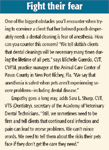Brush up on dental care
You know the routine all too well: Mr. Smith visits with his rambunctious English springer spaniel, Burt, and all goes well until you mention Burt's oral health. Enter the blank stare. Or the anxious shifting from foot to foot. Or even the hasty, "Oh, he's fine!"
You know the routine all too well: Mr. Smith visits with his rambunctious English springer spaniel, Burt, and all goes well until you mention Burt's oral health. Enter the blank stare. Or the anxious shifting from foot to foot. Or even the hasty, "Oh, he's fine!"

Few conversations are trickier than getting clients on board with proper dental care. But serious health issues can stem from a messy mouth, so it's up to you to drive home just how important it is that Burt gets the dental care his health depends on.
STEP 1: Getting started
"You have to start educating the client about oral care from the first visit," says Sara L. Sharp, CVT, VTS (Dentistry), secretary of the Academy of Veterinary Dental Technicians. "Every time a patient walks through your clinic's door, lift the pet's lip and look at the mouth. Pretty soon, the client's going to wonder what you're looking at and pay attention."
At Windsor Veterinary Clinic in Windsor, Colo., the preventive oral health program begins with each wellness exam. "Nurses and doctors thoroughly check the health of teeth and gums," says Michael Hernandez, a veterinary assistant at the practice. "Then we show owners any problems, such as any abnormalities in bite, periodontal issues, dental calculi, gingivitis, or oral tumors, and the doctor discusses these issues with the client at length."
They also preach at-home oral care, Hernandez says. Trained veterinary nurses discuss toothbrushing in the exam room, where they offer a daily brushing recommendation.

12 Answers to clients' top questions
"We use dental models to show areas of high concern and we brush the pet's teeth to show how to brush correctly," he says. "By showing how to brush the teeth in the exam room, family members can see how easy toothbrushing can be at home. And for owners who can't use a toothbrush, we recommend brushing with cotton gauze wrapped around the finger with toothpaste daubed on the end."
Each client leaves the practice with a dental care package. Goodies include a list of common questions and answers a seven-day summary with pictures called "How to Brush Your Pet's Teeth," a bevy of brochures, a free toothbrush, sample toothpaste, and a sample dental rawhide chew.
Likewise, at the Animal Care Center of Pasco County in New Port Richey, Fla., dental visits come stocked with plenty of client education. "We do before-and-after photographs, which clients love," says practice manager Michelle Guercio, CVT, CVPM. "We also give away the first bottle of after-care preventive solution and give clients a copy of their pets' oral charts."
STEP 2: Connect the dots
You know Burt's kicking case of halitosis is more than a cosmetic problem—it's a sign of disease. And convincing clients that bad breath is the first step on the road to serious health problems could be a life-or-death conversation for Burt. "Clients simply don't understand what bad dental care can do to an animal," says Louise Dunn, a practice management consultant with Snowgoose Veterinary Management Consultants in Greensboro, N.C. "And it's up to team members to drive that point home."
Clients who visit your clinic want two things, Dunn says. They want the doctor to tell them what their pets need to stay healthy. And the second part of the equation? "They need team members to tell them that they're making the right decision and they're doing what's best for their animals," she says. "They need to hear, 'That's what I do, or would do, for my pet.'"
STEP 3: Overcome resistance
"I try to gear a home care program toward the patient's needs and consider what clients are able and willing to provide," says Sharp. "Ultimately, brushing daily is the best. However, clients have a hard time taking care of their teeth properly, let alone their pets' teeth. The American Dental Association reports that only 10 percent of people take care of their own teeth properly, so now we're looking at maybe 10 percent of that 10 percent who are protecting their pets' teeth."
The good news: The market is packed with products that can help clients keep their pets' teeth clean—with minimal effort. Several brands of high-quality food help cut down on tartar buildup. Then there are oral hygiene solutions, rawhide chews infused with a dental enzyme, and toys and treats to help cut down on plaque buildup.

Fight their fear
"All animals are fed, all get treats, so why not choose products that promote a healthier mouth?" Guercio asks.
Finally, remember this adage: You catch more flies with honey than vinegar. Gentle, supportive concern will win clients' compliance much better than a sharp tone and a critical eye. "We shouldn't judge our clients if they come to us for care, even if an animal's mouth is really bad," Sharp says. "We need to remember that this person is here now for help, and it's up to us to help in any way we can."